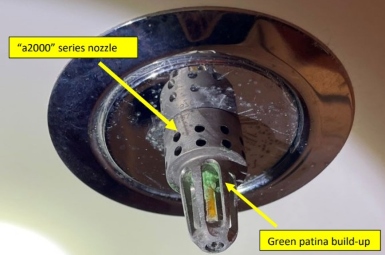
The U.S. Coast Guard (USCG) has issued a safety notice highlighting the risk of green patina build-up on high-pressure water mist nozzles, which can compromise the effectiveness of onboard firefighting systems. According to the notice, while witnessing routine testing of a fixed firefighting system during an annual exam aboard a foreign passenger vessel, the Coast Guard discovered multiple high-pressure water mist nozzles that were incapable of discharging water. Consequently, the firefighting system failed to activate in multiple accommodation spaces.
Upon expanding the examination, Port State Control Officers determined that the high-pressure water mist nozzles in question were manufactured by Marioff (“a2000” series) as part of the “HI-FOG” system. The accumulation of green patina on the nozzles, a sign of corrosion, rendered them unable to release water after the glass bulb broke. The high-pressure water mist nozzles are designed to hold the standard line pressure of 25 bars (363 PSI).
When the glass bulb thermal actuator (shown in the photo above) reaches a certain temperature, it breaks, activating the release mechanism which allows water to flow through the nozzle at the standing pressure. The system then senses the drop in pressure and activates the high-pressure pumps which increases the pressure to 140 bars (2,031 PSI).
This increased pressure is required for the system to achieve an effective release of water in a mist form. The manufacturer, Marioff, released a Service Bulletin (001/2012) and Quality Bulletin (002/2012), which originated due to failures of the “a1000” series nozzles. The bulletins describe the same failure as that noted on the “a2000” series during the recent examination and includes recommended actions that apply to both the “a1000” and “a2000’ series nozzles.
Marioff recommends that if a nozzle fails to release at the standing pressure of 25 bars after the glass bulb is broken, the high-pressure pumps must be manually energized to raise the pressure to 140 bars. Doing so will activate the release mechanism allowing water to flow through the nozzle.
During the examination the Coast Guard witnessed this recommended action and observed that raising the pressure of the system to the recommended 140 bars did not activate the release mechanism of the nozzles as expected. Thus, in this case, the actions recommended by Marioff in Service Bulletin (001/2012) and Quality Bulletin (002/2012) did not raise the system pressure sufficiently to activate the release mechanisms for the nozzles.
The Coast Guard strongly recommends the following actions for vessel owners, operators, and compliance personnel:
- Evaluate whether training for crew members responsible for firefighting system maintenance and compliance walkthroughs adequately covers the inspection of high-pressure water mist nozzles for green patina corrosion.
- Conduct an inspection of all high-pressure water mist nozzles across the vessel to identify any potential issues and consider whether more frequent inspections are necessary. Sprinklers with the highest risk of corrosion include sprinklers more than 10 years old and those located in high moisture and corrosive atmospheres. Areas of high moisture could include outer decks, spas, pool areas, galleys, or even normal passenger and crew areas close to external doors. Review the manufacturer’s service and quality bulletins for more information.
- Contact the manufacturer if any signs of green patina build-up are observed on high-pressure water mist nozzles and consider replacing the affected nozzles.
Download the Safety Alert: USCG: green patina build-up on water mist nozzles